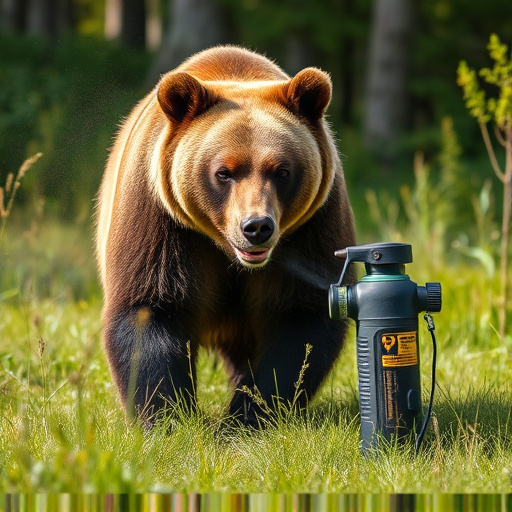Understanding the true effective range of bear spray – around 15 feet – is vital for safety in bear country. This range is influenced by user skill, weather, and product specs. Preventing accidental discharges through proper deployment techniques, such as direct application to a bear's face, calm demeanor, and aiming low, is crucial. Always inspect the canister, keep it securely closed, and use as a last resort, aiming for the bear's face and eyes.
“Bear spray, a popular defense against aggressive bears, is often marketed with a thirty-foot effective range. However, this number is not set in stone. In this article, we debunk the ‘myth’ of the thirty-foot range and explore factors that truly influence its effectiveness. We provide actionable strategies to prevent accidental bear spray discharges, ensuring safe encounters while hiking or camping. Learn how to handle and use bear spray properly to avoid unwanted interactions with these majestic yet potent creatures, focusing on preventing accidental discharges.”
- Understanding Bear Spray Range: The Thirty-Foot Myth
- Factors Influencing Effective Range: Beyond the Number
- Strategies for Preventing Accidental Discharge
- Safe Handling and Usage Tips to Avoid Unwanted Encounters
Understanding Bear Spray Range: The Thirty-Foot Myth
Understanding Bear Spray Range: The Thirty-Foot Myth
Many people believe that bear spray is effective up to a range of thirty feet, but this notion can be misleading. It’s important to clarify that the actual effective range varies significantly based on several factors, including the user’s skill, weather conditions, and the specific product used. The recommended distance for accurate deployment is closer to fifteen feet, where the spray cloud is dense enough to deter a bear effectively. Beyond this range, the spray becomes less concentrated, potentially allowing the bear to avoid or ignore it.
Accidental bear spray discharge prevention is crucial in scenarios where people hike, camp, or backpack in bear country. Misunderstanding the range can lead to incorrect usage, putting individuals at risk. It’s not just about knowing the thirty-foot myth; it’s about understanding how and when to deploy bear spray for maximum effectiveness. Users should practice their application techniques and familiarize themselves with the product’s instructions to ensure they’re prepared in case of a bear encounter.
Factors Influencing Effective Range: Beyond the Number
The effective range of bear spray, often touted as a crucial tool for wilderness safety, is typically advertised at thirty feet (10 meters). However, understanding the factors influencing this range goes beyond simply knowing the distance. Wind conditions play a significant role; a strong breeze can carry the spray much further or dissipate it more quickly than calm air, affecting its overall effectiveness.
Another critical aspect is the angle of discharge. Spraying directly into the bear’s face offers better results than attempting to hit a bear that’s at an angle, as the chemical agents need direct contact with the animal’s eyes and nose for maximum impact. Additionally, environmental conditions such as humidity and temperature can impact how far the spray travels and how long it remains potent, reminding users of the importance of careful handling and awareness during use, aiming to prevent accidental bear spray discharges.
Strategies for Preventing Accidental Discharge
Preventing accidental bear spray discharge is paramount for safe and effective use, especially in close encounters with bears. First, always inspect the canister before deployment; ensure it’s intact, the seal is secure, and the trigger is not stuck. Proper handling involves keeping the nozzle away from your body and face until ready to deploy—a mistake that can lead to self-inflicted injuries or accidental discharge.
Second, maintain a safe distance and remain calm when facing a bear. Avoid sudden movements or loud noises that might provoke an attack. Keep bear spray readily accessible, but avoid pointing it at bears unless absolutely necessary. Practice proper deployment techniques by aiming low, towards the bear’s legs, where it is least likely to be blown back in your face.
Safe Handling and Usage Tips to Avoid Unwanted Encounters
When carrying bear spray, it’s crucial to understand its effective range—thirty feet. This knowledge should be accompanied by safe handling and usage tips to avoid unwanted encounters. Always keep the can in a secure, closed position until needed; accidental discharge prevention is key. Store it outside of your accommodation and away from heat sources or direct sunlight. Before using, ensure the nozzle is not blocked and the spray mechanism is intact.
During outdoor activities, remain calm if you encounter a bear. Make yourself appear larger by raising arms or a jacket overhead. Speak firmly but avoid aggressive language. If a bear shows no sign of leaving, use your bear spray only as a last resort. Aim for the bear’s face and eyes from thirty feet away. Keep spraying until the bear departs or until the can is empty—usually around five to six seconds.
Bear spray is an essential tool for self-defense in grizzly country, but understanding its effective range beyond the common thirty-foot myth is crucial for preventing accidental discharges and ensuring safety during outdoor adventures. By recognizing factors like wind, terrain, and bear behavior that can influence the spray’s reach, you can employ effective strategies to avoid unwanted encounters. Remember, proper handling and usage tips are vital to prevent accidental discharge, making your experience in wild environments safer and more enjoyable.
